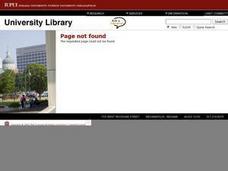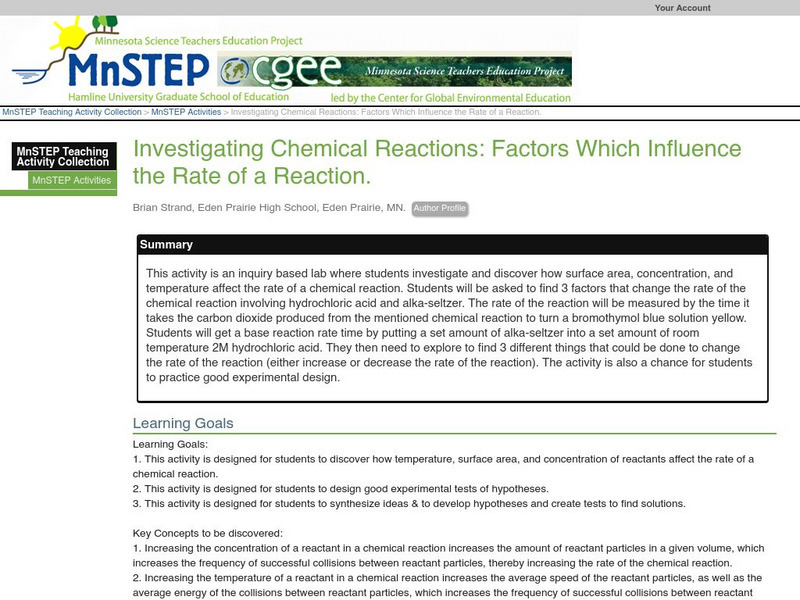Curated OER
Adventures With Maps And Globes
First graders examine the differences between a map and a globe. They discuss and identify the symbols on maps and globes, then in small groups complete a worksheet. Students then complete a Venn Diagram comparing maps and globes.
Curated OER
Japanese Designs
Fourth graders learn some traditional Japanese designs and what they represent, then make their own stamps for printing Japanese designs.
Curated OER
Electronic Hydrology Lesson Plan - Revised
Pupils use Excel spreadsheets. They predict time and height of peak flow on river
Curated OER
Let's Catch Some Dirt From the Air
Students create "catchers" that collect dirt particles from the air. They observe the particulate matter that is collected from the air and discuss the effects and causes of air pollution.
Curated OER
Did You Feel That? Earthquake Data Chart
Students plot earthquakes on the world map using coordinates of longitude and latitude. They designate the earthquakes magnitude with a symbol which they include in the map key.
Curated OER
Studies of the Eastern Worlds: Cultural Maps
Seventh graders look for similarities and differences in the culture of Eastern World countries by looking at the art from each country. They test their hypothesis and assumptions through further research in the media center. Finally...
Curated OER
Imagery on Fabric
Learners practice placing images on their completed quilts. Using their quilt they made in an earlier activity, they print off photographs from a printer and use heat to transfer them to the fabric. They share their quilts with the class.
Curated OER
Water Quality Monitoring
Students comprehend the four parameters of water quality. They perform tests for salinity, dissolved oxygen, pH and clarity or turbidity. Students comprehend why scientists and environmental managers monitor water uality and aquatic...
Curated OER
World Map and Globe
Students explore symbols. In this beginning map instructional activity, students identify common picture symbols. Students place post-it notes with symbols drawn on them in the appropriate place on a map.
Better Lesson
Better Lesson: Nets and Surface Area
A conceptual understanding of finding surface area using nets instead of a formula.
Shodor Education Foundation
Shodor Interactivate: Surface Area of a Rectangular Prism
This lesson teaches students how to find the surface area of rectangular prisms.
Shodor Education Foundation
Shodor Interactivate: Surface Area of Prisms
This lesson teaches students how to find the surface area of non-rectangular prisms.
CPALMS
Cpalms: Building Graduation Caps
[Free Registration/Login Required] For this lesson, learners build geometric models of graduation caps using stiff paper. The activity requires the application of skills in finding surface area, understanding similarity, knowing the...
Illustrative Mathematics
Illustrative Mathematics: G Mg How Thick Is a Soda Can? Variation I
For this task, students are given the dimensions of a soda can and are asked to estimate its thickness. They must first find the surface area and the volume of aluminum. Aligns with G-MG.A.1 and G-MG.A.2.
TeachEngineering
Teach Engineering: Boxed in and Wrapped Up
Students find the volume and surface area of a rectangular box (e.g., a cereal box), and then figure out how to convert that box into a new, cubical box having the same volume as the original. As they construct the new, cube-shaped box...
Science Buddies
Science Buddies: Shape Changing With the Cyber Squad
In this project, you will make 2-dimensional templates, called nets, that fold up into 3-dimensional (3-D) shapes. By making shapes of different sizes, you will be able to see how 3-D shapes change with size. In your findings you will...
PBS
Pbs Teachers: Soak It Up [Pdf]
Compare three prototypes of paper towels using strategies to find the best value in terms of cost and quality. Determine the surface area of a water stain on a paper towel using a transparent grid.
Alabama Learning Exchange
Alex: Cutting the Cheese
The students will find the area of each two dimensional figure on a net of a triangular prism. In groups, students will cut out the net and create a triangular prism. Groups will then discuss how to find the lateral area and the total...
Alabama Learning Exchange
Alex: Thinking Outside the "Box"
The students will find the area of each two dimensional figure on a net of a rectangular prism. In groups, students will cut out the net and create a rectangular prism. Groups will then discuss how to find the lateral area and the total...
Alabama Learning Exchange
Alex: Painting the Pyramids
The students will find the area of each two dimensional figure on a net of a square pyramid. In groups, students will cut out the net and create a square pyramid. Groups will then discuss how to find the lateral area and the total...
Science Education Resource Center at Carleton College
Serc: Investigating Chemical Reactions: Factors Which Influence Rate of Reaction
In this activity, students investigate and discover how surface area, concentration, and temperature affect the rate of a chemical reaction. This lab is designed for students to practice good experimental tests of hypotheses, synthesize...
National Council of Teachers of Mathematics
The Math Forum: Building a Pyramid
This Math Forum lesson gives instructions on how to build a paper pyramid. Bonuses included finding the surface area and volume of the pyramid.
Alabama Learning Exchange
Alex: Popcorn Bucket or Box?
In this exploration, students will apply their knowledge of finding volume and surface area of cylinders and rectangular prisms. Students will make recommendations to the local movie theater after determining which package is cost...
Alabama Learning Exchange
Alex: Nifty Nets
During this activity, students will create nets for prisms. They will find the volume and surface area of the shapes. They will also use interactive activities to review three-dimensional shapes.This lesson plan was created as a result...






















